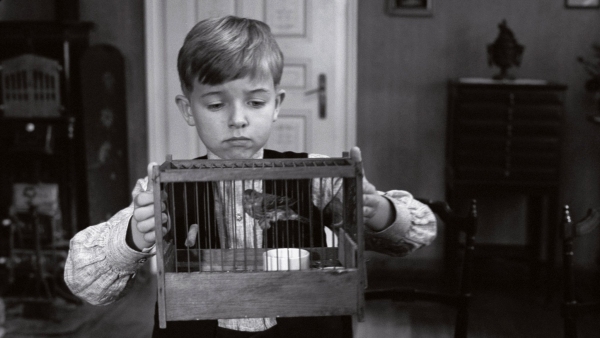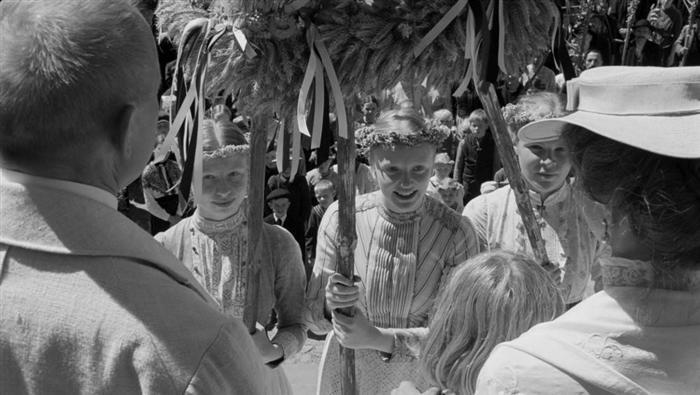If you would like to wallow awhile in visions of apocalypse this week, where are you going to turn to: the special effects splurgefest that is Roland Emmerich's 2012 (reviewed here) or the remorseless austerity of Michael Haneke'sThe White Ribbon? Their respective audiences may be almost entirely mutually exclusive. But, say what you like about the contemporary cinema (and some say it's going through a mini-Armageddon of its own), nobody can legitimately complain that it's not catering for all tastes.If you would like to wallow awhile in visions of apocalypse this week, where are you going to turn to: the special effects splurgefest that is Roland Emmerich's 2012 (reviewed here) or the remorseless austerity of Michael Haneke'sThe White Ribbon?
Palme d'Or hot in hand from this year's Cannes, Haneke is currently the emperor of international art cinema. Only recently, though, he was in the doghouse for his poorly-received American remake of his own 1997 disquisition on violence, Funny Games. For his comeback, the director has chosen to work in his native language for the first time in 12 years, and in that uniquely Germanic genre, the Heimatfilm.
Patriotic, romantic, profoundly sentimental, the "homeland film" as this most untranslatable of concepts is known in English, commemorates a naive pastoral world untouched by modern life. It flowered in the 1950s, as a battered post-war Germany fought to regain its sense of national pride and identity. More recently, directors like Rainer Werner Fassbinder produced ironic revisionist versions of the myth in films such as Katzelmacher. For British viewers, Edgar Reitz's epic, century-spanning Heimat cycle has been, until now, the best-known example.
The White Ribbon is set just before the First World War in a small village in Northern Germany dozing in a quasi-feudal lifestyle under the twin auspices of the landed gentry and the Protestant church. As the story begins, this peace is shattered by a stream of perturbing accidents. First the local doctor breaks his collarbone when his horse is brought crashing down by a tripwire (animal-lovers may baulk at this explicit scene); then a farm worker's wife dies in a fatal fall.
The violence escalates in the course of a year amid the quietly changing seasons. A barn is burned down. Children are beaten, trussed up and tortured. We shouldn't feel too sorry for the doctor, since soon enough he's found cruelly humiliating his mistress and sexually abusing his 14-year-old daughter.  Just for once, Haneke offers minuscule flickers of warmth. The schoolteacher - whose older self narrates the story - launches into the shy, gently comic courtship of a young governess. And there's even something alarmingly close to a Steven Spielberg moment in the scene where an adorable, saucer-eyed little boy offers his father his treasured pet bird when the father's own canary becomes yet another casualty of the malfeasance. But, for the rest, one character who wants out just about sums it up: "Malice, envy, apathy, brutality".
Just for once, Haneke offers minuscule flickers of warmth. The schoolteacher - whose older self narrates the story - launches into the shy, gently comic courtship of a young governess. And there's even something alarmingly close to a Steven Spielberg moment in the scene where an adorable, saucer-eyed little boy offers his father his treasured pet bird when the father's own canary becomes yet another casualty of the malfeasance. But, for the rest, one character who wants out just about sums it up: "Malice, envy, apathy, brutality".
The trailer presents The White Ribbon as a highbrow whodunnit, much in the manner of Haneke's 2005 arthouse hit Hidden. But - while the blustering police officers never nail the culprits - this film makes no secret of who they are: the dead-eyed, thin-lipped, Aryan-blonde children who swarm through the village in gangs and keep popping up at the crime scenes, to ask innocently if they can help out at all.
These children are themselves victims, however, whether it be of corporal punishment, molestation or a simple lack of love. The film wants to show how violence begets violence; and how, as the opening voice-over portentously suggests, these local atrocities "might clarify something that happened later in this country." The white ribbon, a badge of purity which the pastor's children are required to wear, is clearly intended to presage the guilt-stained armband sported by Germans two decades later.
Does this sound, perhaps, a little glib? Well, not for nothing did Haneke win his golden prize in Cannes. His visual style, as seen in the extract above, is icily controlled and highly distinctive. The film is shot in black-and-white, the luminous landscapes offset with cramped interiors dimly lit by oil lamps and haunted by the neurotic spirit of German Expressionism. Staircases abound. And he systematically places his camera - which rarely moves - behind his characters' backs, with bodies or heads dominating the frame (even relatively light-hearted moments like the harvest festival, pictured top, are filmed in this way). It sets up a subtle pattern of disequilibrium, menace, distance. Haneke keeps you at arm's length, constantly blocking you from plunging fully into his world.
I found The White Ribbon disquieting, but not for the intended reasons. For all that the director insists his films are thought-provokingly open-ended, it seemed a little too pat, a bit too insistent - it browbeats us into acquiescence with its jaundiced view of human nature. Does a straight line lead from the child unjustly shamed and beaten to the concentration camp guard? What of all the many factors, economic, historical and cultural, that contributed to the rise of the Third Reich (or any other evil)? Is his twisted Heimatfilm pointing to a fatal flaw deep in the German psyche? Quizzed about all this recently in the New York Times, Haneke had, of course, a ready - and, to my mind, most unsatisfactory - answer. And it didn't stop me from secretly wishing I'd been to see2012 instead.



Add comment